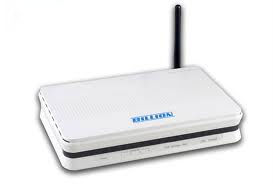HOW TO CONNECT TO THE INTERNET
Step 1: Choose an internet service provider (ISP). This could be the company that provides your telephone line or it could be one of the many independent providers. To help you choose, have a look at one of the many comparison websites and ask people you know for their opinion.
Step 2: Having chosen an ISP and signed the contract, you’ll have to wait a few days while your line is converted to broadband. During this time, you should receive a letter with your username and password and the hardware you’ll need: a small box called a 'router' and its attachments. You can see an example on the right.

Step 3: Once you’re told that your broadband is active, you can set up your router. It should have come with three cables:
- a network cable to connect the router to your computer
- a power cable
- a cable that will go between your router and a micro filter (see below).
- Plug one end of the network cable into the appropriately shaped socket in the router, and the other end in a similarly appropriately shaped socket in your computer.
Take the power cable and plug one end in the router and the other in a nearby power point.
 You should have also received a micro filter (see left). This splits the signal in the telephone wire in two: voice and broadband. You plug the dangle end of the micro filter into your telephone socket. Then in the sockets at the other end, you plug in (1) the cable from your own telephone and (2) the cable that came with your router. As these two sockets are different shapes, you can’t plug a cable into the wrong socket. Finally, plug in the other end of the router cable into the router itself.
You should have also received a micro filter (see left). This splits the signal in the telephone wire in two: voice and broadband. You plug the dangle end of the micro filter into your telephone socket. Then in the sockets at the other end, you plug in (1) the cable from your own telephone and (2) the cable that came with your router. As these two sockets are different shapes, you can’t plug a cable into the wrong socket. Finally, plug in the other end of the router cable into the router itself.
Step 4: When you get the router, you should also receive a CD. Once you’ve set up the router, all you need to do is put the CD into your computer and follow the step-by-step instructions. If you don’t want to do this yourself, some companies offer a home installation service and, for an extra cost, will send an engineer to set up your broadband connection for you.
